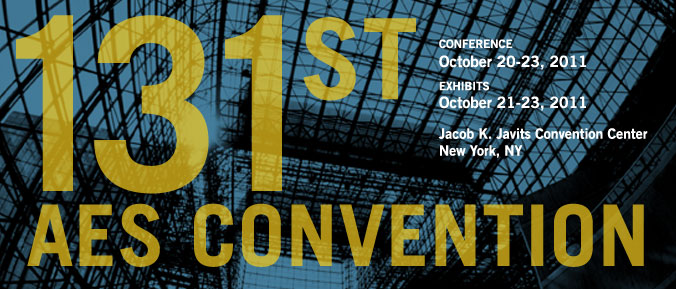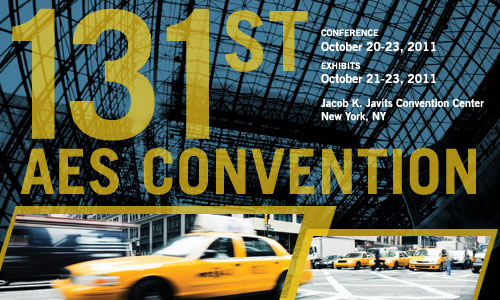
AES New York 2011
Paper Session P5
P5 - Audio Processing—Part 1
Thursday, October 20, 2:30 pm — 4:30 pm (Room: 1E07)
Chair:
Dana Massie, Audience, Inc. - Mountain View, CA, USA
P5-1 Automatic Detection of the Proximity Effect—Alice Clifford, Josh Reiss, Queen Mary University of London - London, UK
The proximity effect in directional microphones is characterized by an undesired boost in low frequency energy as source to microphone distance decreases. Traditional methods for reducing the proximity effect use a high pass filter to cut low frequencies that alter the tonal characteristics of the sound and are not dependent on the input source. This paper proposes an intelligent approach to detect the proximity effect in a single capsule directional microphone in real time. The low frequency boost is detected by analyzing the spectral flux of the signal over a number of bands over time. A comparison is then made between the bands to indicate the existence of the proximity effect. The proposed method is shown to accurately detect the proximity effect in test recordings of white noise and a other musical inputs. This work has applications in the reduction of the proximity effect.
Convention Paper 8475 (Purchase now)
P5-2 Vibrato Detection Using Cross Correlation Between Temporal Energy and Fundamental Frequency—Henrik von Coler, Technical University of Berlin - Berlin, Germany; Axel Röbel, IRCAM - Paris, France
In this work we present an approach for detecting quasi periodic frequency modulations (vibrato) in monophonic instrument recordings. Since a frequency modulation in physical instruments usually causes an amplitude modulation, our method is based on a block wise cross correlation between the extracted frequency- and amplitude-modulation trajectories. These trajectories are obtained by removing the constant components. The resulting cross correlation curve shows significant positive peaks at vibrato regions and local minima at note boundaries. Our approach has the advantage of working without a previous note boundary detection and needs only a small look ahead. Furthermore no presumptions on vibrato parameters have to be made.
Convention Paper 8476 (Purchase now)
P5-3 A Non-Time-Progressive Partial Tracking Algorithm for Sinusoidal Modeling—Maciej Bartkowiak, Poznan University of Technology - Poznan, Poland; Tomasz Zernicki, Telcordia Poland - Poznan, Poland
In this paper we propose a new sinusoidal model tracking algorithm that implements a non-progressive way of data processing. Sinusoidal partial parameters are estimated in the consecutive frames; however, the order of establishing individual connections between partials is optimized within the whole signal or within a specific time window. In this way, the strongest connections may be determined early, and subsequent predictions of each trajectory evolution are based on a more reliable partial evolution history, compared to a traditional progressive scheme. As a consequence, the proposed non-progressive tracking algorithm offers a statistically significant improvement of obtained trajectories in terms of better classic pattern recognition measures.
Convention Paper 8477 (Purchase now)
P5-4 Perceptually Relevant Models for Articulation in Synthesized Drum Patterns—Ryan Stables, Jamie Bullock, Ian Williams, Birmingham City University - Birmingham, UK
In this study we evaluate current techniques for drum pattern humanization and suggest new methods using a probabilistic model. Our statistical analysis shows that both deviations from a fixed grid and corresponding amplitude values of drum patterns can have non-Gaussian distributions with underlying temporal structures. We plot distributions and probability matrices of sequences played by humans in order to demonstrate this. A new method for humanization with structural preservation is proposed, using a Markov Chain and an Empirical Cumulative Distribution Function (ECDF) in order to weight pseudorandom variables. Finally we demonstrate the perceptual relevance of these methods using paired listening tests.
Convention Paper 8478 (Purchase now)
Information Last Updated: 20111005, mei

